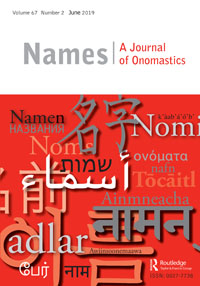Published 2019-04-03
Copyright (c) 2019 American Name Society

This work is licensed under a Creative Commons Attribution 4.0 International License.
Abstract
The naming of a newborn for a deceased relative is a means by which a meaningful connection can be maintained with the dead. This study analyses the birth, marriage and death records of England and Wales to highlight a historic naming custom–that should a child die shortly after birth, their name could often be re-used for a later sibling.
This re-use of names in response to child bereavement is considered in the context of historic and cross-cultural naming customs offering pragmatic responses to infant mortality, such as apotropaic (protective) naming, and within the theoretical framework of ‘continuing bonds’, whereby namesakes can facilitate a post-mortem social life for the deceased. By considering the intricate relationship between one’s name and one’s personhood, the re-use of a name in full, shortly after death, could be interpreted as the symbolic reincarnation of an individual, rather than simply as a commemorative act.
References
- Alia, Valerie. 2009. Names and Nunavut: Culture and Identity in the Inuit Homeland. 1st ed. New York, USA: Berghahn Books.
- Atkins, P.J. 1999. “Milk consumption and tuberculosis in Britain, 1850-1950.” In Order and Disorder: The Health Implications of Eating and Drinking in the Nineteenth and Twentieth Centuries, ed. A. Fenton, 83–95. Edinburgh, UK: Tuckwell Press.
- Barry, Herbert, and Leonora M. Paxson. 1971. “Infancy and Early Childhood: Cross-cultural Codes 2.” Ethnology 10:466–508.
- Bell, Frances, and Robert Millward. 1998. “Public Health Expenditures and Mortality in England and Wales, 1870–1914.” Continuity and Change 13:221–249.
- Bush, Stephen J., A. Powell-Smith, and T.C. Freeman. 2018. “Network Analysis of the Social and Demographic Influences on Name Choice within the UK (1838-2016).” PLoS One 13:e0205759.
- Crespo-Fernández, Eliecer. 2006. “The Language of Death: Euphemism and Conceptual Metaphorization in Victorian Obituaries.” SKY Journal of Linguistics 19:101–130.
- Crespo-Fernández, Eliecer. 2013. “Euphemistic Metaphors in English and Spanish Epitaphs: A Comparative Study.” [Metáforas Eufemísticas En Epitafios Ingleses y Españoles: Un Estudio Contrastivo]. Atlantis 35:99–118.
- Dasen, Véronique. 2011. “Childbirth and Infancy in Greek and Roman Antiquity.” In A Companion to Families in the Greek and Roman Worlds, ed. Beryl Rawson. New Jersey, USA: Blackwell Publishing.
- Dirbas, Hekmat. 2017. Thy Name is Deer. Animal names in Semitic Onomastics and Name-giving Traditions: Evidence from Akkadian, Northwest Semitic and Arabic. PhD, Humanities, Leiden University, Leiden, Netherlands.
- Fang, Hanquan, and J. H. Heng. 1983. “Social Changes and Changing Address Norms in China.” Language in Society 12:495–507.
- Foster, Terrah L, Mary Jo Gilmer, Betty Davies, Mary S Dietrich, Maru Barrera, Diane L Fairclough, Kathryn Vannatta, and Cynthia A Gerhardt. 2011. “Comparison of Continuing Bonds Reported by Parents and Siblings after a Child's Death from Cancer.” Death studies 35:420–440.
- Guemple, D. L. 1965. “Saunik: Name Sharing as a Factor Governing Eskimo Kinship Terms.” Ethnology 4:323–335.
- Irwin, Melissa D. 2015. “Mourning 2.0: Continuing Bonds between the Living and the Dead on Facebook.” OMEGA: Journal of Death and Dying 72:119–150.
- Jonsson, Annika. 2015. “Post-mortem Social Death: Exploring the Absence of the Deceased.” Contemporary Social Science 10:284–295.
- Klass, Dennis. 1993. “Solace and Immortality: Bereaved Parents’ Continuing Bond with their Children.” Death Studies 17. no. 4:343–368.
- Klass, Phyllis R. Silverman, and Steven Nickman, eds. 1996. Continuing Bonds: New Understandings of Grief. Philadelphia, PA: Taylor and Francis.
- Králová, Jana. 2015. “What is Social Death?” Contemporary Social Science 10:235–248.
- Lee, K.S. 2007. “Infant Mortality Decline in the Late 19th and Early 20th Centuries: The Role of Market Milk.” Perspectives in Biology and Medicine 50:585–602.
- Lieberson, Stanley, Susan Dumais, and Shyon Baumann. 2000. “The Instability of Androgynous Names: The Symbolic Maintenance of Gender Boundaries”. American Journal of Sociology 105:1249–1287.
- Macdonald, Charles. 2009. “Inuit Personal Names. A Unique System?” In Orality in the 21st Century: Inuit Discourse and Practices. Proceedings of the 15th Inuit Studies Conference. ed. B. Collignon and M. Therrien. Paris: INALCO.
- McCormick, Albert E. 2010. “Infant Mortality and Child-Naming: A Genealogical Exploration of American Trends.” The Journal of Public and Professional Sociology 3:2.
- McCormick, Lisa. 2015. “The Agency of Dead Musicians.” Contemporary Social Science 10:323–335.
- Mendels, D. 2007. On Memory: An Interdisciplinary Approach. Frankfurt am Main, Germany: Peter Lang.
- Mitterauer, M. 1993. Ahnen und Heilige: Namengebung in der europäischen Geschichte. München: Beck.
- Ogden, Charles Kay, and Ivor Armstrong Richards. 1946. The Meaning of Meaning. San Diego, USA: Harvest Book.
- Okehie-Offoha, Marcellina Ulunma, and Matthew N. O. Sadiku. 1995. Ethnic and Cultural Diversity in Nigeria. Trenton, NJ: Africa World Press.
- Root, Briana L., and Julie Juola Exline. 2014. “The Role of Continuing Bonds in Coping with Grief: Overview and Future Directions.” Death Studies 38:1–8.
- Samuel, Edgar R. 1969. “New Light on the Selection of Jewish Children’s Names.” Transactions & Miscellanies (Jewish Historical Society of England) 23:64–86.
- Scheper-Hughes, Nancy. 1992. Death without Weeping: The Violence of Everyday Life in Brazil. Berkley: University of California Press.
- Seeman, Mary V. 1983. “The Unconscious Meaning of Personal Names.” Names 31:237–244.
- Stroebe, Margaret, and Henk Schut. 2005. “To Continue or Relinquish Bonds: A Review of Consequences for the Bereaved.” Death Studies 29:477–494.
- Toplean, Adela. 2015. “To Resist or to Embrace Social Death? Photographs of Couples on Romanian Gravestones.” Contemporary Social Science 10:296–309.
- Tremearne, A. J. N. 1914. The Ban of the Bori: Demons and Demon-dancing in West and North Africa. London, UK: Routledge.
- Tremearne, Major A.J.N. 2014. Hausa Superstitions and Customs: An introduction to the Folk-lore and the Folk. Abingdon, UK: Routledge.
- Vickio, Craig J. 1999. “Together in Spirit: Keeping Our Relationships Alive when Loved Ones Die.” Death Studies 23:161–175.
- West, Jevin D., Jennifer Jacquet, Molly M. King, Shelley J. Correll, and Carl T. Bergstrom. 2013. “The Role of Gender in Scholarly Authorship.” PLoS One 8:e66212.
- Williams, Victoria. 2016. Celebrating Life Customs Around the World: From Baby Showers to Funerals. Westport, CT: Greenwood Press.

